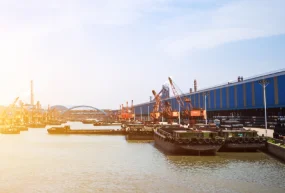
The Suez Canal and Red Sea
Imagine a highway so vital that 12% of the world’s traffic, worth trillions of dollars, flows through it daily. That’s the reality of the Suez Canal and Red Sea, a maritime corridor so crucial that its disruption sends tremors through the global economy. Let’s delve deeper into the stats and figures behind their significance.
Location, Location, Location
Shortest Path: The Suez Canal cuts a 193 km (119 miles) gash through Egypt, slashing the distance between the Mediterranean and the Indian Ocean by a staggering 8,900 km (5,530 miles) compared to sailing around Africa. This translates to:
- Weeks saved: Ships traversing the canal complete their journeys in roughly 11-16 hours, compared to weeks via the Cape route.
- Fuel efficiency: Shorter journeys mean less fuel consumption, reducing shipping costs and environmental impact.
Global Trade Artery
Volume: Over 1.92 billion tonnes of cargo, equivalent to roughly 56 ships per day on average, transited the Suez Canal in 2023. This represents:
- 12% of global trade: By volume, the canal handles a staggering 12% of all goods traded internationally.
- Trillion-dollar value: The estimated value of goods passing through the canal in 2023 stands at a staggering $9.4 billion.
Economic Dependence
Costly Disruptions: Closures or disruptions in the Suez or Red Sea have significant economic consequences:
- Supply chain disruptions: Shortages of essential goods, production slowdowns, and job losses ripple through various sectors.
- Billions in losses: The Ever Given blockage in 2021 resulted in an estimated $9 billion in daily losses due to delays and rerouted shipments.
- Market volatility: Uncertainty and disruptions can lead to fluctuations in commodity prices and economic instability.
Beyond the Numbers
Geopolitical Significance: The Suez Canal and Red Sea are not just economic lifelines; they hold considerable geopolitical weight:
- Regional stability: Secure passage through these waters is crucial for maintaining stability in the region and ensuring smooth international relations.
- International cooperation: Maintaining the safety and efficiency of this critical maritime corridor requires collaboration between nations.
The Numbers Tell a Story
The staggering statistics paint a clear picture: the Suez Canal and Red Sea are not just waterways; they are the arteries of global trade. Their smooth operation is vital for the interconnectedness of our world, and any disruption has the potential to trigger economic tremors felt across continents. Recognizing their importance and ensuring their security is not just a logistical consideration, but a critical aspect of maintaining global economic stability and international cooperation.


